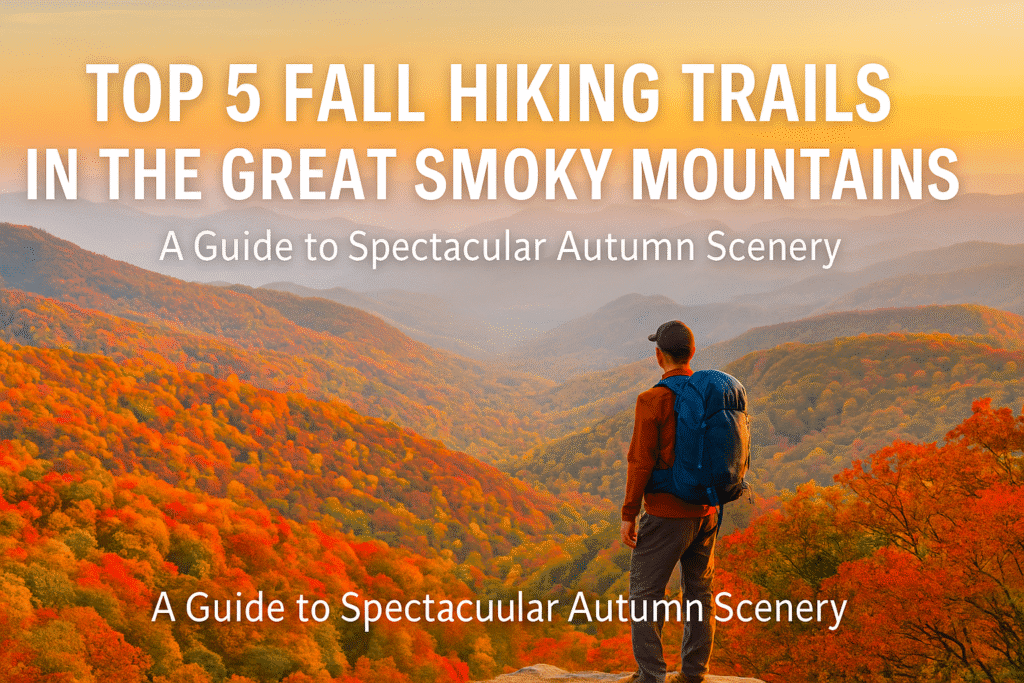
Top 5 Fall Hiking Trails in the Great Smoky Mountains
The Great Smoky Mountains straddling the border of Tennessee and North Carolina are a leaf-peeper’s dream come true. With rich biodiversity, varying elevations, and over 800 miles of hiking trails, fall here is a visual feast. This guide outlines five of the most iconic fall hikes in the Smokies—each delivering vibrant foliage, fascinating terrain, and unforgettable views. Whether you're looking for a short scenic stroll or a challenging summit push, this list has you covered.
1. Andrews Bald – Clingmans Dome Road, Tennessee
- Distance: 3.5 miles round trip
- Difficulty: Moderate
- Elevation Gain: ~900 feet
- Estimated Time: 2–3 hours
This high-elevation trail begins near Clingmans Dome and leads to one of the park’s few grassy balds. Andrews Bald offers an open, panoramic view of the southern Smokies—perfect for catching early season color, typically in late September to early October. The trail has been improved with rock stairs and drainage features, making it easier to navigate during wet conditions.
Fall Foliage Tip: The elevation (over 5,000 feet) makes this one of the first spots in the park to peak in color. Arrive early for parking and avoid midday crowds.
Trailhead Access: Park at Clingmans Dome lot and take the Forney Ridge Trail.
2. Alum Cave Bluffs – Newfound Gap Road, Tennessee
- Distance: 4.6 miles round trip
- Difficulty: Moderate
- Elevation Gain: ~1,100 feet
- Estimated Time: 3–4 hours
This trail offers a little bit of everything—rock formations, tunnels, historic landmarks, and vibrant fall color. Highlights include Arch Rock, Inspiration Point, and the massive Alum Cave Bluffs. The route climbs through diverse forest zones, each showing off unique autumn hues. Fog often settles in the valleys below, adding dramatic contrast for photos.
Fall Foliage Tip: Mid-October is typically peak for this elevation range. Sunrise hikes deliver magical light filtering through golden canopy.
Trailhead Access: Located 8.7 miles south of the Sugarlands Visitor Center on Newfound Gap Road.
3. Gregory Bald – Cades Cove, Tennessee
- Distance: 11.3 miles round trip
- Difficulty: Strenuous
- Elevation Gain: ~3,000 feet
- Estimated Time: 6–8 hours
Gregory Bald is famous in summer for its flame azaleas—but come October, it’s a hotspot for fiery maples and sweeping views of Cades Cove and the western Smokies. The long hike pays off with unobstructed fall panoramas and a peaceful bald summit where you can rest and picnic amid rolling, golden ridges.
Fall Foliage Tip: Peak colors usually hit mid to late October. Consider camping at nearby backcountry sites for sunrise/sunset views.
Trailhead Access: Parson Branch Road (seasonally closed); check access before visiting. Alternative: Gregory Ridge Trail from Forge Creek Road.
4. Little River Trail – Elkmont, Tennessee
- Distance: 4.9 miles round trip
- Difficulty: Easy to Moderate
- Elevation Gain: ~400 feet
- Estimated Time: 2–3 hours
This former railroad grade follows the Little River through a quiet valley filled with yellow birch, beech, and maple. It’s a gentle, shaded hike ideal for families and those who want to enjoy fall color without a challenging climb. The path is lined with river cascades, stone walls, and remnants of Elkmont’s early 20th-century cabins.
Fall Foliage Tip: Expect peak color in mid to late October. Bring a picnic to enjoy riverside at one of the many clearings along the trail.
Trailhead Access: Drive into the Elkmont area and follow signs to the Little River Trail parking area.
5. Clingmans Dome – Tennessee/North Carolina Border
- Distance: 1-mile round trip
- Difficulty: Easy (but steep)
- Elevation Gain: ~330 feet
- Estimated Time: 30–45 minutes
At 6,643 feet, Clingmans Dome is the highest point in Great Smoky Mountains National Park and offers 360° panoramic views from its iconic observation tower. It’s one of the few paved trails in the park and accessible to most visitors. In fall, you’ll see the full gradient of autumn—from evergreen spruce-fir forests at the top to flame-colored hardwoods far below.
Fall Foliage Tip: Because of its elevation, this is one of the earliest places to see color—typically in late September to early October. Dress warmly—it’s often 10–20°F cooler than surrounding areas.
Trailhead Access: Parking lot at the end of Clingmans Dome Road (seasonal).
Conclusion
With elevations ranging from 875 to 6,643 feet, the Great Smoky Mountains offer a prolonged and diverse fall season. From grassy balds and misty ridgelines to riverside trails and forested bluffs, these five hikes showcase the very best of the Smokies in autumn. Whether you're a seasoned hiker or a casual nature lover, lace up your boots and get ready to experience fall at its finest.
Frequently Asked Questions (FAQ)
When does fall foliage peak in the Smoky Mountains?
Higher elevations (above 4,000 feet) typically peak in late September to early October, while mid to lower elevations turn by mid to late October. The entire season can span 4–5 weeks.
Is Clingmans Dome open year-round?
Clingmans Dome Road usually closes from December 1 through March 31 due to snow and ice. The observation tower is accessible by foot year-round if you’re up for the hike.
Do I need a permit to hike in the Smokies?
No permits are required for day hiking. However, overnight backcountry camping does require a permit and reservation.
👉 Want more scenic hikes and gear-tested reviews? Visit our reviews page.